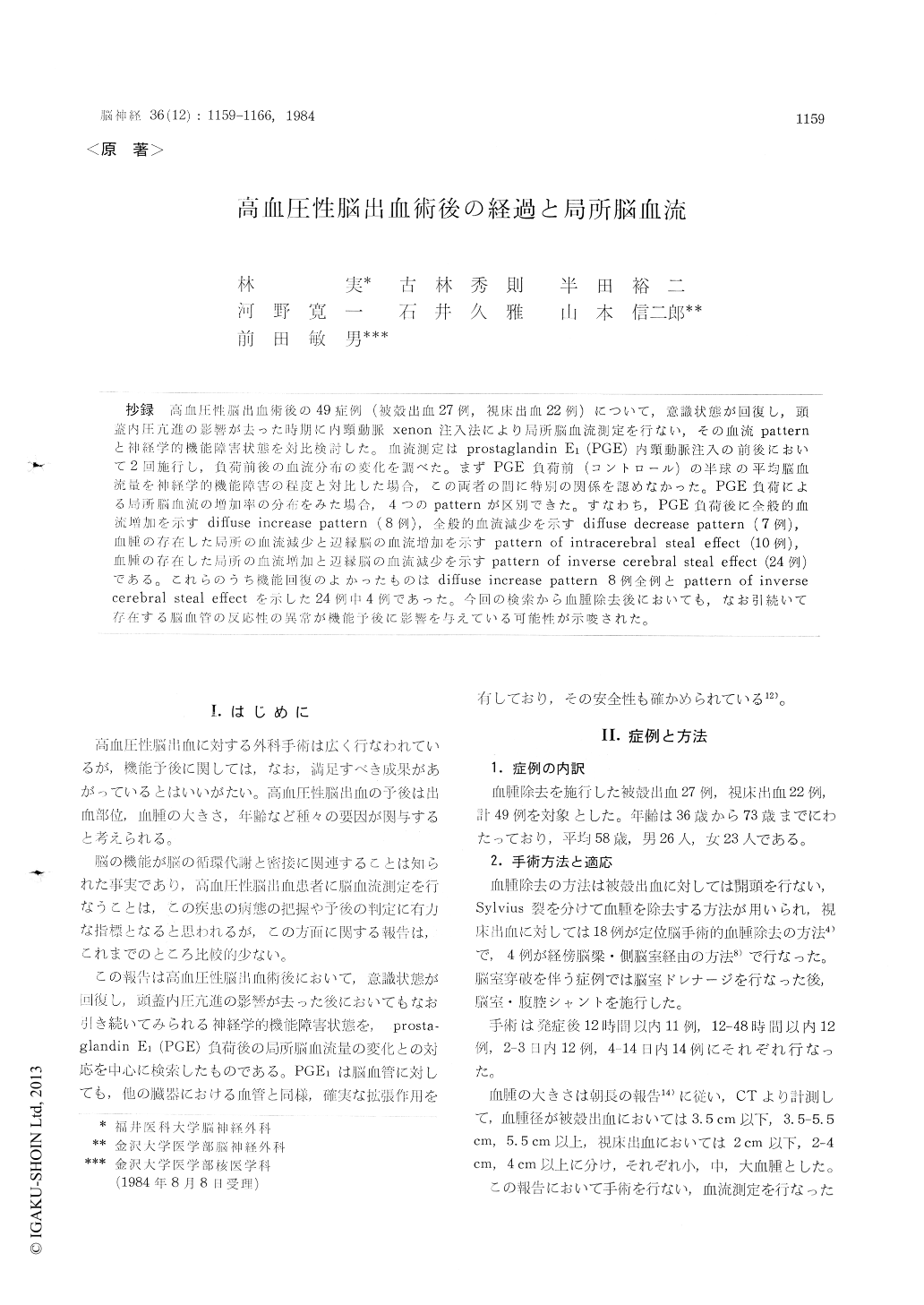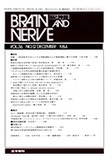Japanese
English
- 有料閲覧
- Abstract 文献概要
- 1ページ目 Look Inside
抄録 高血圧性脳出血術後の49症例(被殻出血27例,視床22例)について,意識状態が回復し,頭蓋内圧亢進の影響が去った時期に内頸動脈xenon注入法により局所脳血流測定を行い,その血流patternと神経学の機能障害状態を対比検討した。血流測定はprostaglandin E1(PGE)内頸動脈注入の前後において2回施行し,負荷前後の血流分布の変化を調べた。まずPGE負荷前(コントロール)の半球の平均脳血流量を神経学の機能障害の程度と対した場合,この両者の間に特別の関係を認めなかった。PGE負荷による局所脳血流の増加率の分布をみた場合,4つのpatternが区別できた。すなわち,PGE負荷後に全般的血流増加を示すdiffuse increase pattern (8例),全般的血流減少と辺縁脳の血流増加を示すdiffuse decrease pattern (7例),血腫の存在した局所の血流減少と辺縁脳の血流増加を示すpattern of intracerebral steal effect (10例),血腫の存在した局所の血流増加と辺縁脳の血流減少を表すpattern of inverse cerebral steal effect (24例)である。これらのうち機能回復のよかったものはdiffuse increase pattern 8例全例とpattern of inversecerebral steal effectを示した24例中の4例であった。今回の検索から血腫除去後においても,なお引続いて存在する脳血管の反応牲の異常が機能予後に影響を与える可能性が唆された。
Regional cerebral blood flow (rCBF) was mea-sured in 49 patients with surgically treated hy-pertensive intracerebral hemorrhage (putaminal hemorrhage 27: thalamic hemorrhage 22). The hematoma evacuation was performed within 14 days after the hemorrhage.
For the measurement of rCBF, the intracarotid xenon-133 injection method was used. Two rCBF studies were performed on all patients, the first giving the resting state of the brain perfusion, the second after Prostaglandin E1(PGE) adminis-tration into the internal carotid artery 10 minute after the first study.(PGE was administered 10μg in 5 minutes.) In all patients blood pressure and arterial carbon dioxide tension were examined before and after each CBF study.
The evaluation was made by comparing the rCBF maps obtained before and after PGE admi-nistration. (A rate of rCBF increase was calculated by dividing each rCBF value obtained after PGE administration by each rCBF value obtained before PGE administration (control value), and the ratio was multiplied by 100.)
The PGE-induced reaction patterns were divided into four; the first is the diffuse increase pattern, characterized by a diffuse increase of rCBF values in the hematoma-evacuated area and the surround-ing brain; the second is the diffuse decrease pat-tern, characterized by a global decrease of rCBFvalues in the hematoma-evacuated area and the surrounding brain; the third is the pattern of intracerebral steal effect, characterized by a de-crease of rCBF in the hematoma-evacuated area and an increase of rCBF values in the surrounding brain; and the fourth is the pattern of inverse cerebral steal effect, characterized by an increase of rCBF in the hematoma-evacuated area and a decrease of rCBF in the surrounding brain. The diffuse increase pattern was seen in eight patients, all of whom were in good neurological conditions. The diffuse decrease pattern was noted in seven patients, and the pattern of intracerebral stealeffect was observed in 10 patients, all of whom were in poor neurological status. The pattern of inverse cerebral steal effect included 24 patients. Four out of the 24 patients were in good condi-tion, whereas the remaining 20 patients were in poor neurological conditions. It is suggested that the degree of recovery of vascular reactivity to vasodilating agents, such as PGE, not only near the site of hematoma-cavity but also in the whole brain, correlated well with the neurological condi-tions.

Copyright © 1984, Igaku-Shoin Ltd. All rights reserved.


